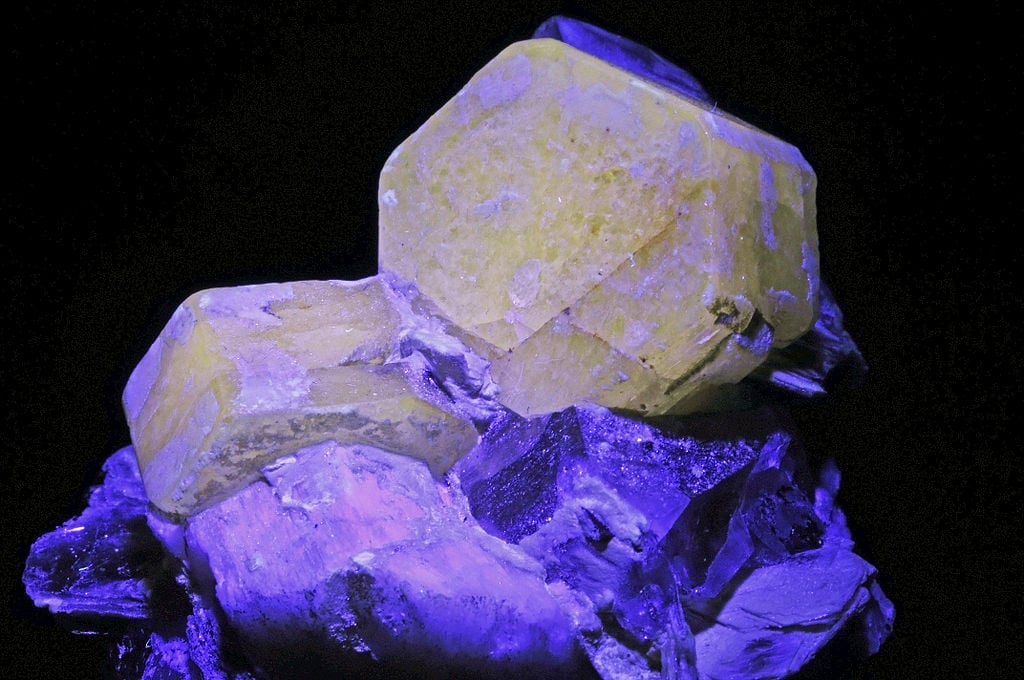What is Gemstone Luminescence?
Gemstone luminescence is a glow that occurs when certain stones are subjected to energy such as UV light. This effect can help gemologists identify gems.
2 Minute Read
Some minerals glow or fluoresce under ultraviolet (UV) light, such as some shown here. Apatite, quartz, orthoclase feldspar, and muscovite under normal white light and UV light. Photos by Géry Parent. Licensed under CC By-SA 3.0.
What Can Gemstone Luminescence Indicate?
Gemstone luminescence can help gemologists differentiate between certain natural and synthetic gems. However, for gem identification purposes, gemologists usually analyze luminescence in conjunction with other tests. Collectors also prize crystal specimens with spectacular luminescent displays.
What's the Difference Between Fluorescence and Phosphorescence?
If the absorbed energy is released almost immediately, the effect is called fluorescence. If there is a delay in the release of the energy (ranging from seconds to hours), the effect is then called phosphorescence.
What is Triboluminescence?
Some gems may produce light when subjected to friction (when held or rubbed). This is called triboluminescence. Examples of gems that may be triboluminescent include dolomites, fluorites, and sphalerites.
What Kind of Energy Causes Luminescence?
X-rays, visible light, and even heat can provide the energy to excite the electrons in minerals. (Some minerals may react to multiple types of energy). However, gemologists most commonly use ultraviolet light (UV) to trigger gemstone luminescence.
Some gemstones fluoresce even in normal visible light or daylight. When backlit with daylight or halogen light, the transparent areas of this lavender fluorite crystal fluoresce an intense "grape juice" purple. 7.7 x 5.7 x 5.3 cm, Greenlaws Mine, Daddry Shield, Weardale, North Pennines, Co. Durham, England. © Rob Lavinsky, www.iRocks.com. Used with permission.
What is Longwave and Shortwave Ultraviolet Light?
There are two kinds of UV light, longwave (LW) and shortwave (SW).
- LW UV light has a wavelength of 3660 Å (or 366 nm). Fluorescent lamps can generate LW UV light.
- SW UV light has a wavelength of 2587 Å (or 258.7 nm). Special quartz tubes can generate SW UV light.
Some gemstone minerals display luminescence in LW, some in SW, some in both, and some in neither. Gems from different sources may also have different luminescent properties.
In many cases, UV light won't excite a mineral unless it contains an impurity element that functions as an activator. The element manganese, for example, plays such a role in many minerals. Conversely, the element iron quenches fluorescence in most minerals.
This pink manganoan (manganese-rich) calcite fluoresces a vibrant reddish orange. 13.5 x 10.5 x 10.1 cm, Huanggang Mines, Keshikteng, Ulahad Bnner, Inner Mongolia A.R., China. © Rob Lavinsky, www.iRocks.com. Used with permission.
Joel E. Arem, Ph.D., FGA
Dr. Joel E. Arem has more than 60 years of experience in the world of gems and minerals. After obtaining his Ph.D. in Mineralogy from Harvard University, he has published numerous books that are still among the most widely used references and guidebooks on crystals, gems and minerals in the world.
Co-founder and President of numerous organizations, Dr. Arem has enjoyed a lifelong career in mineralogy and gemology. He has been a Smithsonian scientist and Curator, a consultant to many well-known companies and institutions, and a prolific author and speaker. Although his main activities have been as a gem cutter and dealer, his focus has always been education. joelarem.com
International Gem Society
Related Articles
Tugtupite Value, Price, and Jewelry Information
Apatite Value, Price, and Jewelry Information
Andalusite Value, Price, and Jewelry Information
Alexandrite Value, Price, and Jewelry Information
Latest Articles
800 Years of Mogok: A Celebration in Tenuous Times
What is the Average Gemstone Faceting Yield?
Pyroxmangite Value, Price, and Jewelry Information
How to Identify Emerald Simulants and Synthetics
Never Stop Learning
When you join the IGS community, you get trusted diamond & gemstone information when you need it.
Get Gemology Insights
Get started with the International Gem Society’s free guide to gemstone identification. Join our weekly newsletter & get a free copy of the Gem ID Checklist!
